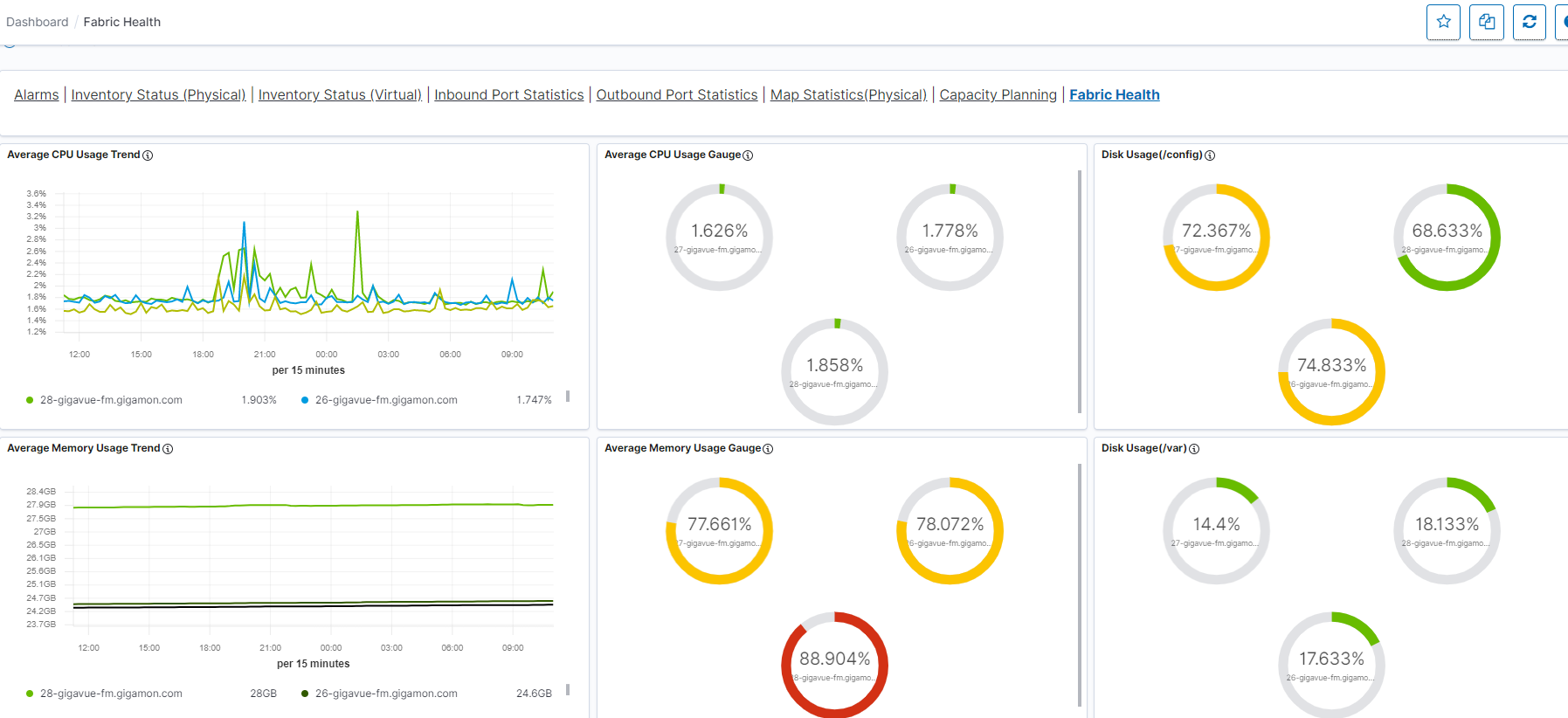Fabric Health Analytics (BETA)
Fabric Health Analytics is delivered as BETA in software version 5.12.00 and is subject to change in the upcoming release(s).
Fabric Health Analytics (FHA) in GigaVUE-FM is a standalone service that provides data visualization capabilities for the following entities in GigaVUE-FM:
- Physical resources, specifically the nodes and the ports
- Virtual resources
- Alarm Management services
- GigaVUE-FM CPU, Memory and Disk Storage services
Using FHA you can create visual elements such as charts that are embedded as visualizations. The visualizations are grouped together in dashboards. You can also create search objects using FHA. Dashboards, Visualizations and Search Objects are called FHA objects.
Fabric Health Analytics provides the following advantages:
- Real-time data for visualization as the required data is taken from GigaVUE-FM.
- Application of RBAC on the data to be analyzed and visualized.
- Trending Analysis: Visualize the trends in the traffic using pre-defined widgets
- Capacity Planning: Utilization of resources based on health and inventory summary data
To view the Fabric Health Analytics GUI embedded into GigaVUE-FM:
- On the left navigation pane, click on
 .
. - Select Analytics BETA. The following options are available:
- Dashboards: Refer to the Dashboards section for details.
- Visualization: Refer to the Visualizations section for details
- Discover: You can view the data in the elastic search database of GigaVUE-FM. You can also create Search Objects that can be used in dashboards/visualizations.
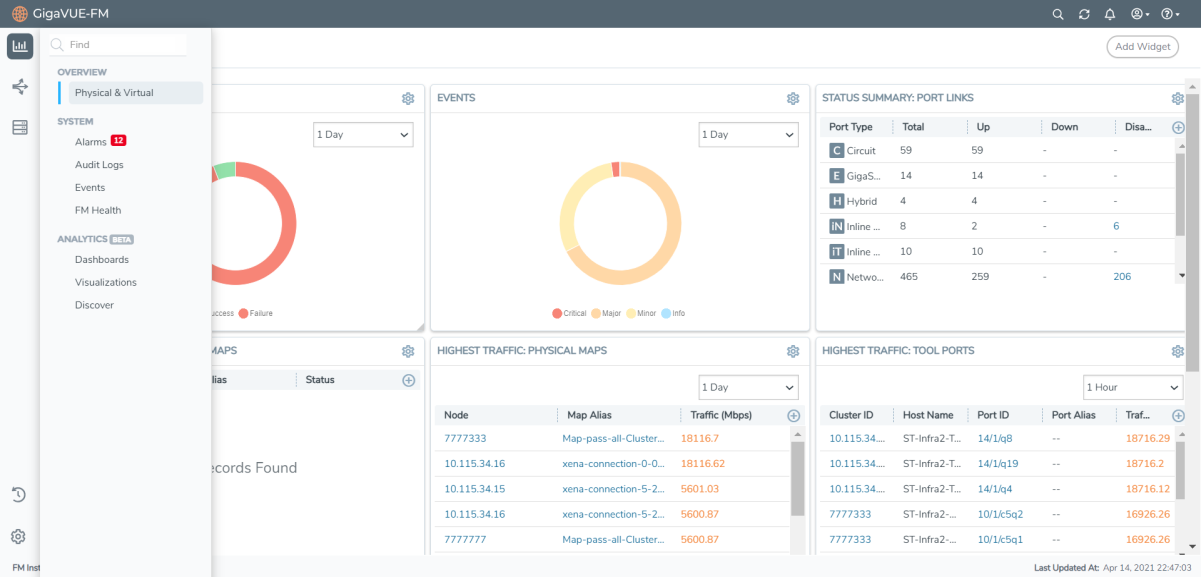
Rules And Notes for Fabric Health Analytics BETA
- All GigaVUE-FM users can create, edit and delete FHA objects. However, you can perform these operations only on the FHA objects created by you. You cannot view or edit the FHA objects created by other users.
- You cannot delete or edit system-defined objects such as dashboards and visualizations.
- There is no limit on the number of dashboards per user.
- The data available in dashboard is controlled by Role Based Access Control. That is, the data fetched depends on the accessibility rights of the user based on the user role and user-defined tags.
- GigaVUE-FM backup/restore operation will not preserve the custom dashboards and visualizations created by the user.
- Refer to Kibana documentation for detailed functionality.
- Dashboards/visualizations created in release 5.11.00 will not be supported in the upcoming releases. You must create the required dashboards again.
Visualizations
Visualization refers to the visual representation of data in various forms such as pie charts, time series graphs and other visual elements.
Using FHA you can:
- View System Visualizations
- Create Custom Visualizations
View System Visualization
System visualizations are pre-defined visualizations that are available by default in GigaVUE-FM. To view the system visualization:
- Click the Dashboard icon on the left navigation pane.
- Select Analytics Beta > Visualizations.
- Choose the required system visualizations.
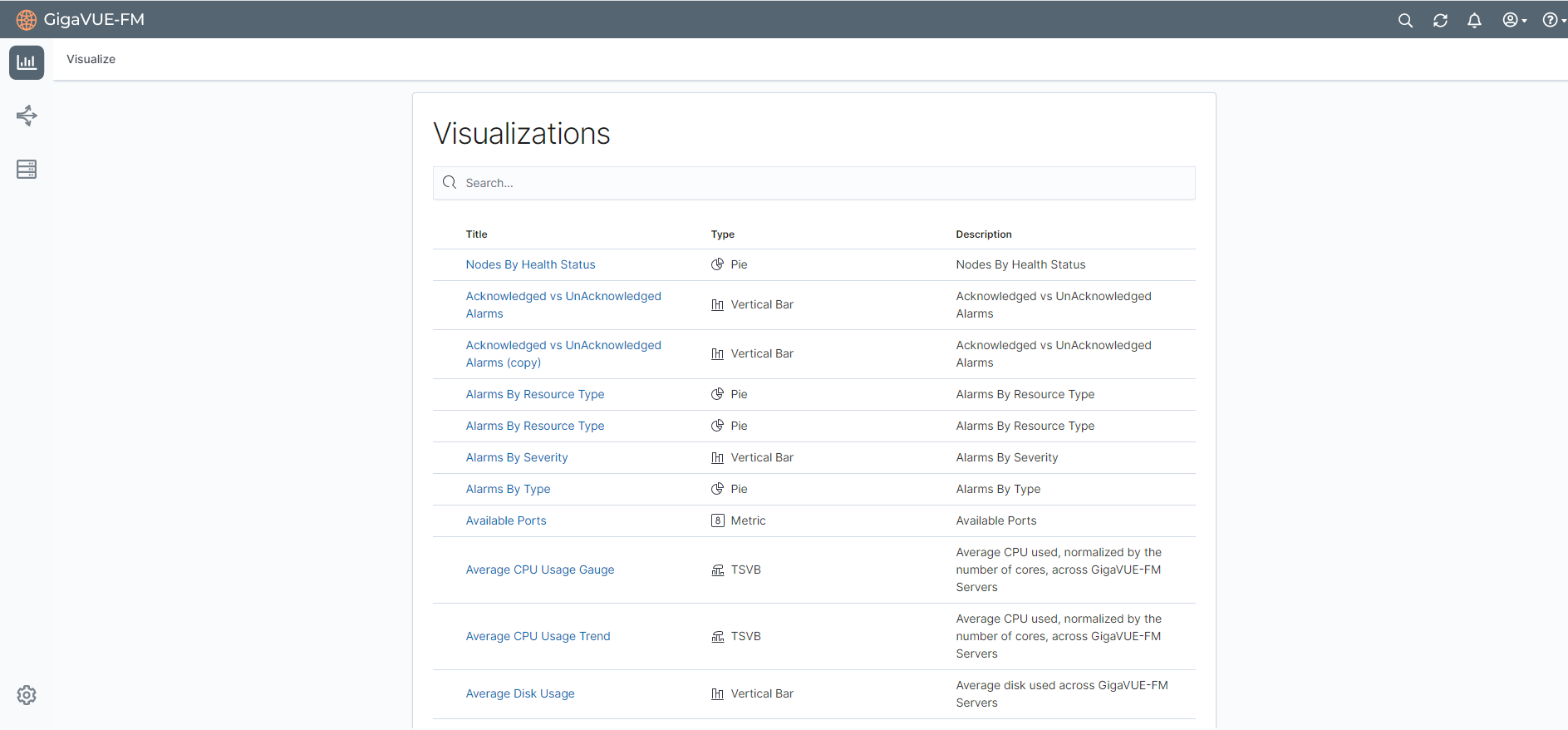
Create Custom Visualizations
You can create custom visualizations by cloning the existing system visualizations or creating a new visualization.
Clone a Visualization
To clone a visualization:
- On the left navigation pane, click on
 . Select Analytics > Visualization.
. Select Analytics > Visualization.
- Select the visualization for which you need to create a clone.
- Make the required changes.
- Click Save As.
- Enter a name for the new Visualization.
- Click Save As. The new visualization will be added to the list page.
Create a Visualization
To create a new visualization:
- On the left navigation pane, click on
 . Select Analytics > Visualization.
. Select Analytics > Visualization.
- Click Create Visualization.
- In the New Visualization page, select the required Visualization Type.
- Select the data source for the visualization.
- Enter the required details for the type of visualization selected. Refer to the table below for more details.
- Click Save.
- In the Save Visualization dialog enter the Title and Description for the visualization and click Save.
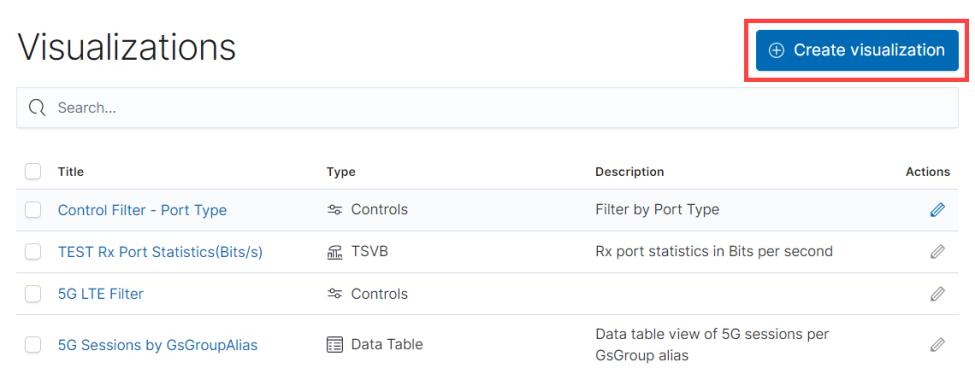
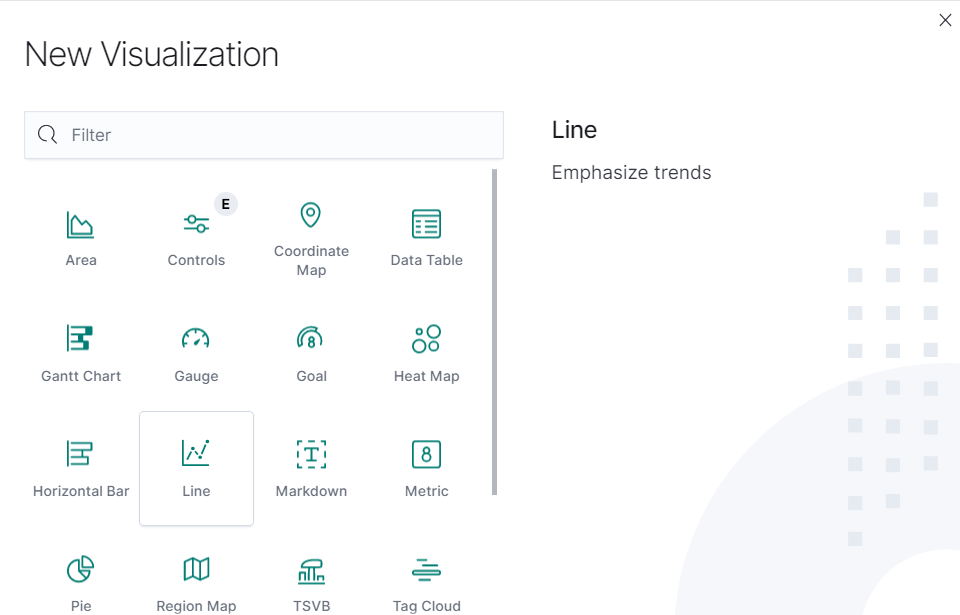
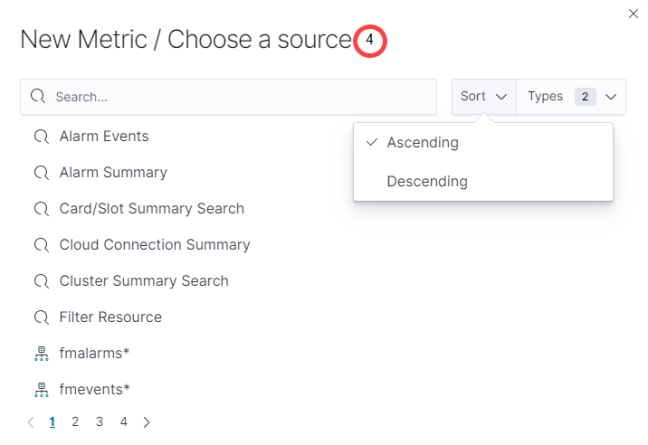
| Type of Visualization | Description |
|---|---|
| Metric | Displays a single number for the selected aggregation. |
| Data table | Displays the raw data of a composed aggregation. |
| Pie Chart | Display each source’s contribution to a total. |
| TSVB | Combines an infinite number of aggregations and pipeline aggregations to display complex data in a meaningful way |
| Line Chart, Area Chart, Horizontal and Vertical Bar charts | Compares different series in X/Y charts. |
| Heat maps | Shade cells within a matrix. |
| Markdown widget | Display free-form information or instructions. |
| Goal and Gauge | Displays a gauge |
| Coordinate map | Associate the results of an aggregation with geographic locations. |
| Region map | Thematic maps where a shape’s color intensity corresponds to a metric’s value. |
Dashboards
A dashboard is a collection of visualizations. Click on Analytics Beta > Dashboard. The Alarms dashboard page, which is the default dashboard page appears.
To view all dashboard click the Dashboards menu on the top navigation bar.
From the Dashboards page, you can:
- View System Dashboards
- Create Custom Dashboard
The system dashboards is the list of pre-defined dashboards created in GigaVUE-FM:
Dashboard | Description | |||||||||||||||
| Alarms | The alarms dashboard page contains the following visualizations:
| |||||||||||||||
| Inventory Status (Physical) | Displays status of the physical resources such as the number of clusters, standalone nodes, number of ports and cards. You can also select the required cluster id to view the ports, nodes and cards by type and health.
| |||||||||||||||
| Inventory Status (Virtual) | Status of the virtual resources such as the number of GvTAPs, V Series nodes, monitoring domains for the various platforms. | |||||||||||||||
| Inbound Port Statistics | Statistics of the receiving (Rx) ports in packets per second, bytes per second. You can select the cluster id, port type, port id and port alias based on which you can filter the statisitics. | |||||||||||||||
| Outbound Port Statistics | Statistics of the transmitting (Tx) ports in packets per second, bytes per second. | |||||||||||||||
| Map Statistics | Statistics of the packets. | |||||||||||||||
| Capacity Planning | Capacity of the TCAM resource availability and its usages. | |||||||||||||||
| Fabric Health | Displays GigaVUE-FM health details on a timely basis:
Note: In case of GigaVUE-FM High Availability group, the GigaVUE-FM Health dashboards display the visualizations for the three GigaVUE-FM instances of the High Availability group.
|
You can change the default dashboard page:
- Navigate to the specific dashboard page.
-
Click
 to set this dashboard page as default.
to set this dashboard page as default.
Note: You cannot edit or delete the system dashboards. However, you can create your own personalized dashboards as per your requirements.
You can create custom dashboards by cloning the existing system dashboards or creating a new dashboard.
Refer to the following sections for details:
Clone Dashboard
To clone a dashboard:
Go to any of the dashboard pages based on which you need to create a custom dashboard.
- Click the Clone button on the submenu bar.
 .
. - Enter a name for the new dashboard and click Confirm Clone. The new dashboard is created.
-
You can perform the following operations on the new dashboard:
- Remove the visualizations that you no longer need on the new dashboard.
- Remove the navigation links on the top.
- Add existing visualizations to your dashboard. Create new visualizations to the dashboard.
- Edit the newly added visualizations as per your requirements.
- Click Save to save the dashboard.
- Click Edit to make additional edits to the new dashboard.
You can add a link to the custom dashboard using the markdown menu option.
Create New Dashboard
To create a new dashboard:
- Click Dashboard on the top navigation bar. The dashboards listing page is listed.
- Click Create Dashboard.
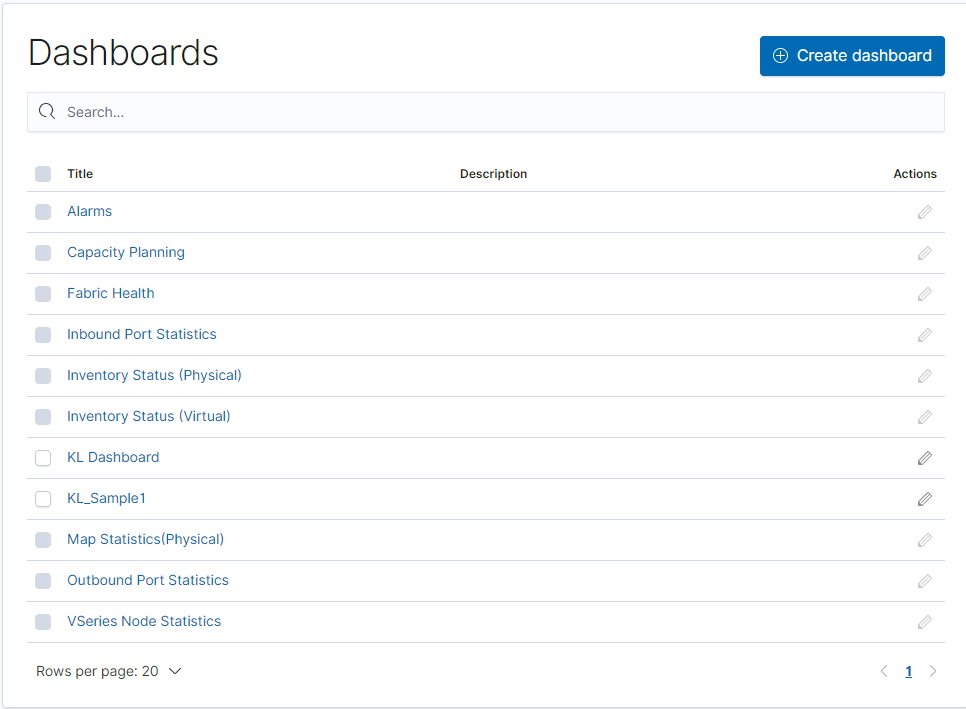
- Add existing visualizations to the dashboard. You can also create new visualizations and add it to the dashboard.
- Click Save to save the dashboard with a name.
mFilter Data in Visualizations
Fabric Health Analytics provides various options to add filter to your data:
Time Filter: Use time filter to retrieve search results for a specific time period.
Use the Refresh option to refresh the dashboards for the selected time interval. It is recommended to configure a longer time interval.
Use Quick Select option to change the time interval.
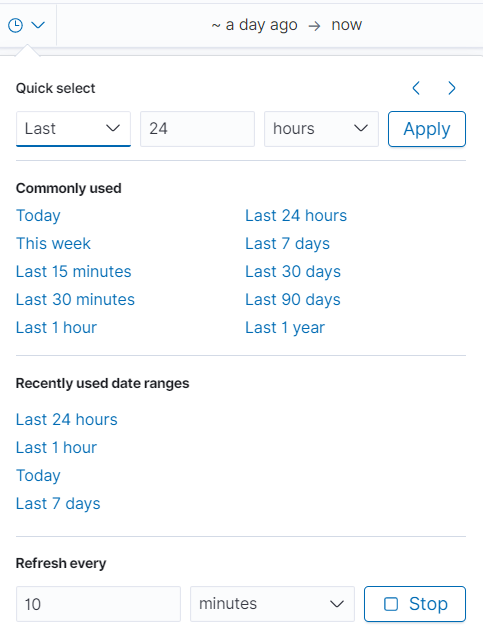
Use the CHANGE ALL FILTERS to configure the following options:
- Enable all: Enables all saved filters
- Disable all: Disables all saved filters
- Pin all: Filter is applied to all the dashboards
- Unpin all: Filter is no longer applied to all the dashboards
- Invert Inclusion: Included filters will be inverted.
- Invert enabled/disabled: Enable and disable options are inverted
- Remove all: Removes all filters
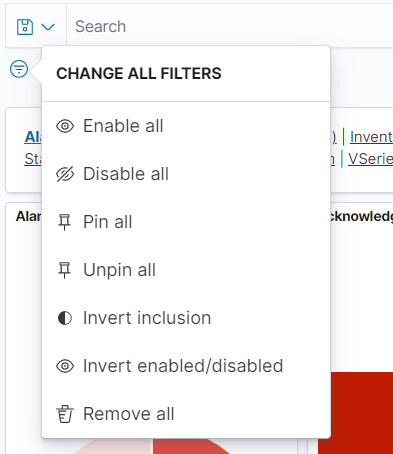
Filtering in visualizations:
- Select and drag an area of the visualization for a specific time interval. All the visualizations in the dashboard get updated for that time interval. The time interval also gets updated in the Quick Select.
- Double click on an area in the visualization and select the required filters to apply.
Control Visualizations: Use Control Visualizations to filter the data based on tags. For example, in the Inbound Port Statistics visualization, you can filter the data based on the cluster id, port number, port id or port alias. Refer to the following sections:
 .
.

Auto Refresh Tags in Visualizations 
In Fabric Health Analytics, the data is saved as index patterns in the Elastic Search database and is fetched into the various fields in the visualizations. However, when you add tag ids dynamically in GigaVUE-FM and associate the tags to the various resources, the tag ids are not automatically refreshed in the visualizations. To add the new tags in visualizations:
Create new tag key and tag values from the tags page. Refer to the Create User-defined Tag section in the GigaVUE Administration Guide.
- Associate the resources to the tag keys and tag values. For example, to add tag key and tag values to the physical nodes, refer to the Add New Physical Node or Cluster to GigaVUE‑FM
- Click on
 Refresh Index Pattern icon for the newly added tags to get reflected in the visualization filters in the system and custom visualizations.
Refresh Index Pattern icon for the newly added tags to get reflected in the visualization filters in the system and custom visualizations.
Copy Dashboard Path 
The GigaVUE-FM Analytics page allows you to add links in custom dashboard pages for navigating from one dashboard page to another dashboard page without going to the listing page. To do this:
- Navigate to the custom dashboard page on which you need to add the link.
- Click on
 icon to copy the relative path.
icon to copy the relative path. - Create a new markdown visualization or Edit an existing markdown visualization.
- Paste the link in [Title](RelativePath) format. For example, [Alarms](#/dashboard/fha-alarms).
- Add the markdown visualization to any of the custom dashboards on which the links of other dashboards needs to be added.
